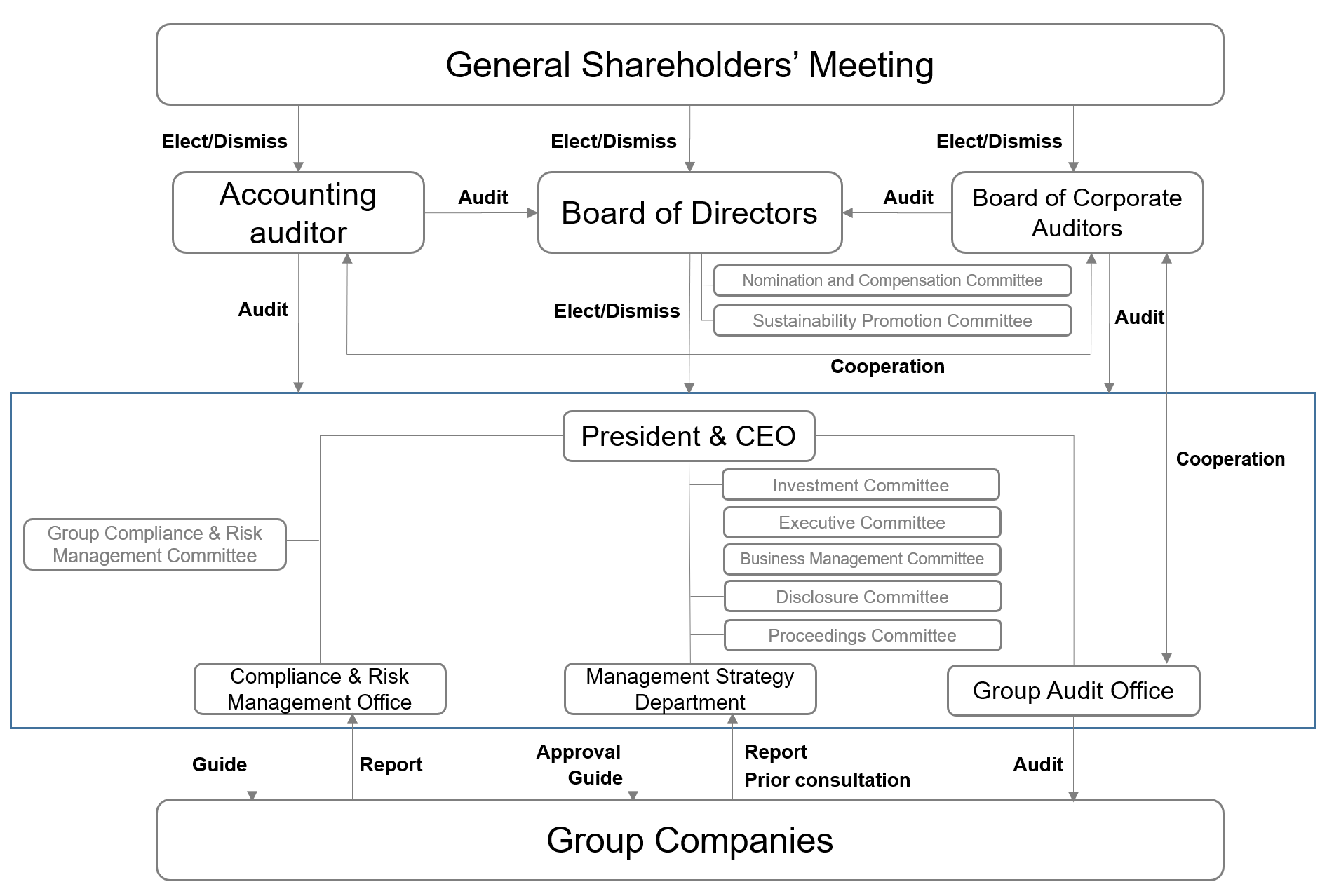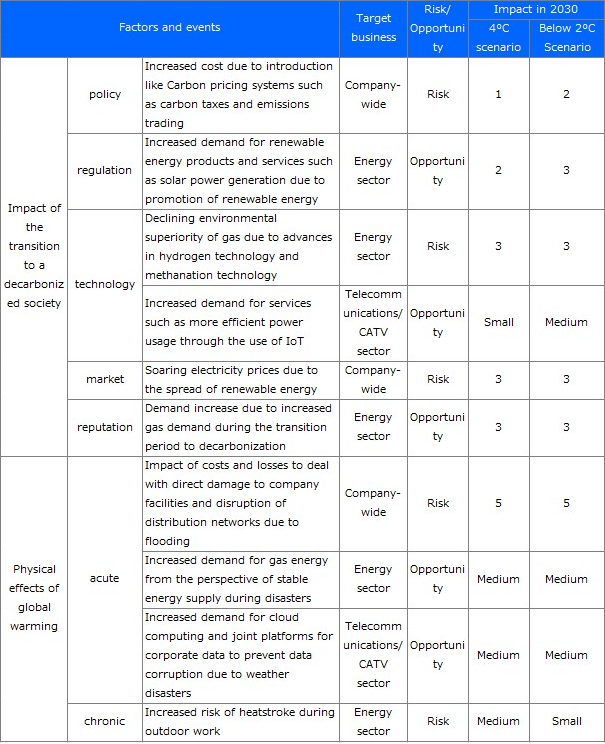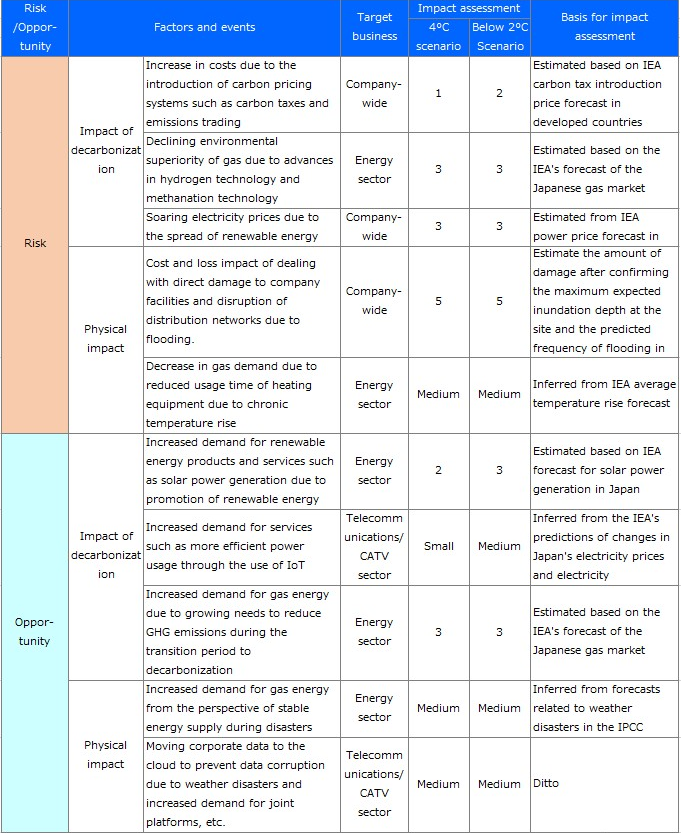Information Disclosure Based on TCFD Recommendations
Information Disclosure Based on TCFD Recommendations
We TOKAI Group have actively worked to solve various issues facing society.In December 2021, the TOKAI Group “Sustainability Declaration” was formulated, and the identified materialities were set as challenges to be addressed and targets to be achieved by 2030.In particular, achieving carbon neutrality by 2050 and addressing climate change issues are social issues that require global-scale efforts, and we recognize that these are important themes that are closely related to the energy we provide.
We believe that identifying climate change risks and opportunities using the TCFD framework, formulating countermeasures, and integrating them into management strategies will contribute to the sustainable growth and enhancement of corporate value of the Group. We are proceeding with the disclosure of relevant information.
Going forward, we will continue to strengthen our group's resilience to climate change issues through scenario analysis, and at the same time contribute to the realization of a sustainable society.

(1) Governance
We aim to contribute to the realization of a sustainable society while actively engaging in social issues such as climate change and The Sustainability Promotion Committee (chaired by the CEO), which is one of the advisory bodies to the Board of Directors, promotes management from a sustainability perspective.This committee is scheduled to meet twice a year to take inventory of materiality and issues to be addressed, and to evaluate the status of efforts to achieve goals.The content of the discussions and measures to address climate-related issues are reported to the Board of Directors, and are executed, directed and supervised with the final resolution and approval of the TOKAI Group management.
(2) Strategy
1.Assumptions for scenario analysis and target projects
In identifying the risks and opportunities posed by climate change issues, we are using scenario analysis to identify and assess the impacts as of 2030 and consider countermeasures. In particular, the gas business, which is our main business, is an energy sector-related business that is expected to undergo large-scale changes in the business environment in the transition plan to decarbonization, and we recognize the necessity to assess the scale of the impact in advance. In our scenario analysis, we referred to multiple scenarios published by the Intergovernmental Panel on Climate Change (IPCC) and the International Energy Agency (IEA). The energy business (TOKAI Co., Ltd./Tokai Gas Co., Ltd.), the information and communication business (TOKAI Communications Co., Ltd.), and the CATV business (TOKAI Cable Network Co., Ltd.) were analyzed.
| 4°C scenario | Below 2°C Scenario | |
|---|---|---|
| View of the world | A world view that assumes that the global average temperature will rise by up to 4°C by 2100 compared to the industrial revolution, and physical damage such as typhoons and floods will expand and intensify. Reference scenarios: IPCC RCP4.5-8.5, IEA STEPS |
A world view assuming that policy regulations will be strengthened and technology will be developed in order to limit the temperature rise to around 1.5°C by promoting decarbonization. Reference scenarios: IPCC RCP1.9-2.6, IEA SDS/NZE2050 |
| Energy business | Intensifying typhoons and floods may cause damage to our facilities and gas supply network. On the other hand, as the world continues to rely on petroleum-derived energy, we expect demand for conventional energy sources, including LP gas, to continue expanding. | There are concerns that the introduction of a carbon tax will increase gas purchase prices and business operating costs, and we expect that demand for LP gas will stagnate in the future as petroleum-derived energy is avoided. However, as of 2030, quantitative estimates based on external global forecast parameters have confirmed that demand for LP gas will increase as an alternative energy during the transition to decarbonization. Demand for energy and fuels with high environmental advantages, such as LP gas and natural gas, is also expected to grow. |
| Information and communication business / CATV business | We are aware that the direct damage to our facilities and supply chain will increase due to the intensification of typhoons and floods, but for the data center owned by TOKAI Communications Co., Ltd., we have selected in advance a location with a low risk of natural disasters. We have confirmed that the possibility of damage, including suspension of operations, is minor. | Electricity accounts for the majority of the energy used in the information and communications business and the CATV business, so we have confirmed the risk of an increase in business operating costs for both businesses if electricity costs rise as a result of the development and spread of renewable energy. On the other hand, from the perspective of reducing energy consumption in offices, demand for information and communication services such as cloud services may increase due to the spread of corporate smart offices and telework. |
2.Financial impact of scenario analysis
*The impact is evaluated on a scale of 1 to 5 for items that have undergone quantitative analysis, and on a scale of 3 from small to large for items that have undergone qualitative analysis.| Quantitative evaluation | Qualitative evaluation | ||
|---|---|---|---|
| 5 | Profit increase/decrease over 30% | Large | Assumed impact of quantitative indicator 4 or higher |
| 4 | Profit increase/decrease over 10% | ||
| 3 | Profit increase/decrease over 1% | Medium | Assumed impact of quantitative indicator 3 or higher |
| 2 | Profit change less than 1% | Small | Assumed impact of quantitative indicator 2 |
| 1 | no effect | ||
3.Risks and opportunities
*The impact is evaluated on a scale of 1 to 5 for items that have undergone quantitative analysis, and on a scale of 3 from small to large for items that have undergone qualitative analysis.| Quantitative evaluation | Qualitative evaluation | ||
|---|---|---|---|
| 5 | Profit increase/decrease over 30% | Large | Assumed impact of quantitative indicator 4 or higher |
| 4 | Profit increase/decrease over 10% | ||
| 3 | Profit increase/decrease over 1% | Medium | Assumed impact of quantitative indicator 3 or higher |
| 2 | Profit change less than 1% | Small | Assumed impact of quantitative indicator 2 |
| 1 | no effect | ||
4.Strategy conclusion
In May 2021, we announced our "Carbon Neutral Vision" and are working to strengthen our resilience to climate-related issues, including promoting the reduction of greenhouse gas (GHG) emissions.We are exploring the possibility of strengthening our company's resilience and contributing to the local community, such as thorough BCP measures at each site and proposing new energy that responds to decarbonization. These efforts have been incorporated into our business strategy, and we will continue to provide environmentally friendly products and services, reduce greenhouse gas emissions in our customers' lives and business activities, and move corporate data to the cloud and joint platforms. We will improve our corporate value by expanding our services and improving functions, and by supporting our customers' efforts to reduce their environmental impact.
(3) Risk Management
The Sustainability Promotion Committee, an advisory body to the Board of Directors, identifies and evaluates materiality (important issues), including climate-related risks, based on the Basic Sustainability Policy.We select candidates based on sectoral materiality maps, etc., published by each ESG research institution, taking into account regional characteristics, industry trends, and other factors.
After that, we conduct evaluations from the two perspectives of "impact on the corporate value of the Group over the medium to long term" and "impact on society" and select ESG issues that should be given the highest priority.
The Sustainability Promotion Committee considers countermeasures and strategies while periodically reviewing these identified materialities in consideration of changes in industry trends and new ESG issues. Initiatives are finally put into action after resolution and approval by the Board of Directors.
Materiality (important issues)
(4) Metrics and Targets
In the “Carbon Neutral Vision” formulated in May 2021, we announced our goal of achieving carbon neutrality for the entire group by 2050.In addition, with 2030 as the target year, we have also established a medium-term goal to achieve carbon neutrality by reducing 170,000 tons of CO2 emitted from the homes of gas-using customers and 13,000 tons of CO2 generated from our own business activities. doing.The table below shows the results of our group's greenhouse gas emissions.
| Target scope | Fiscal 2021 results |
|---|---|
| Scope1 | 6,875t-CO2 |
| Scope2 | 17,938t-CO2 |
| Scope1+2 total | 24,813t-CO2 |
| Announced on May 20, 2021 | Formulation of "Carbon Neutral Vision" |
|---|




